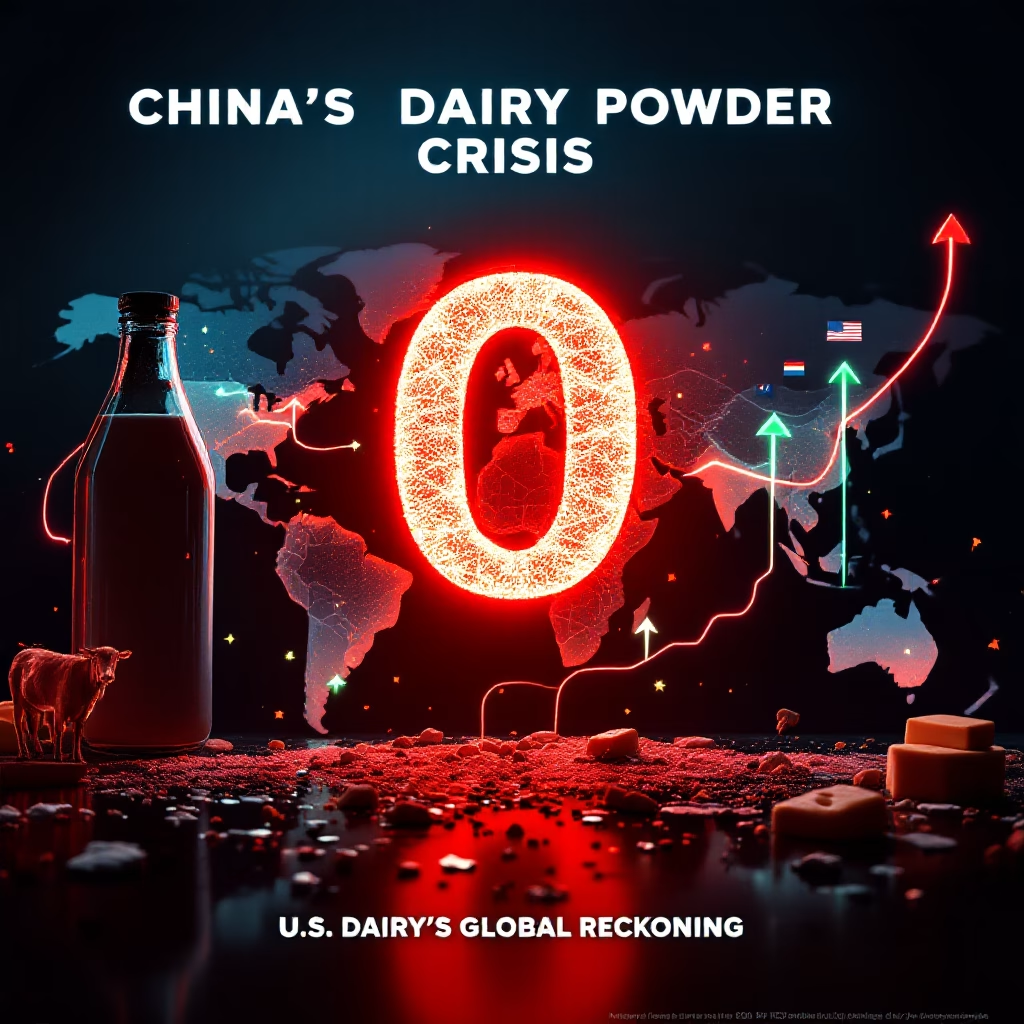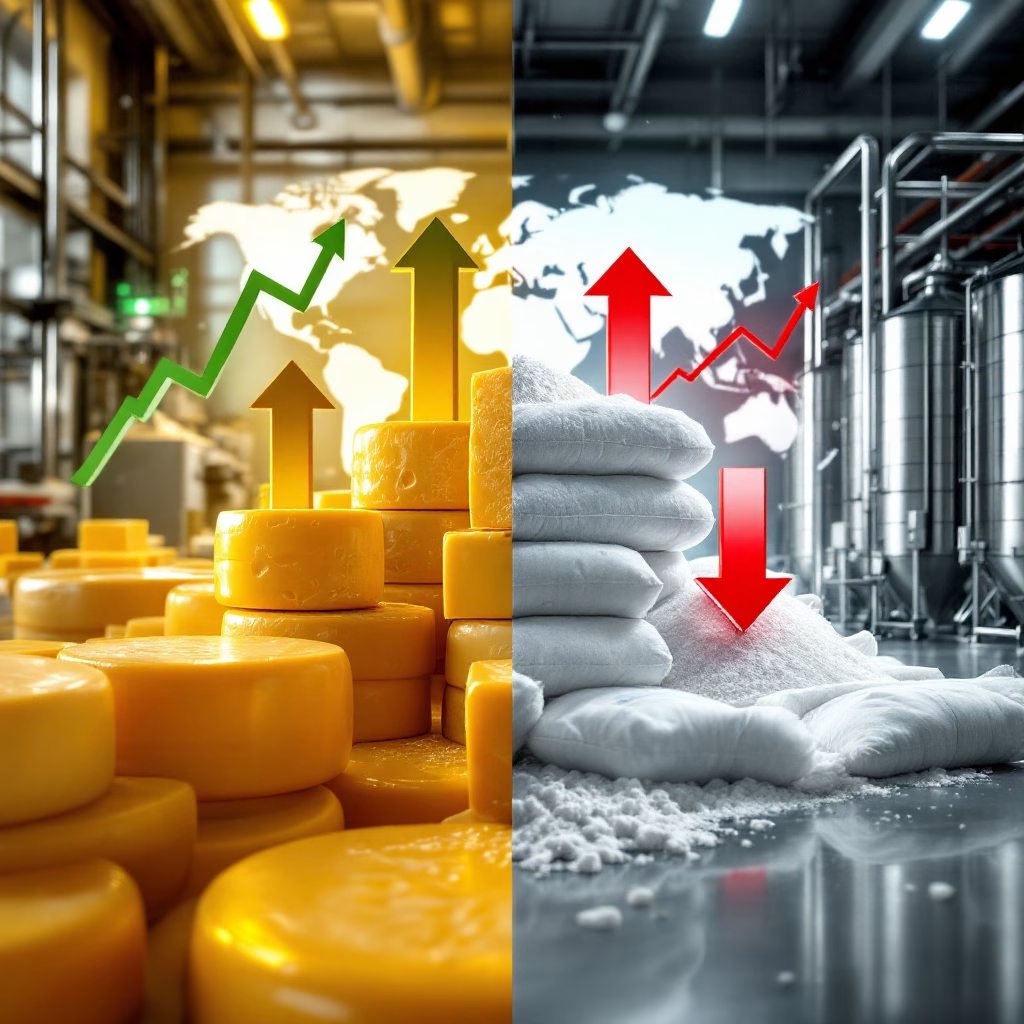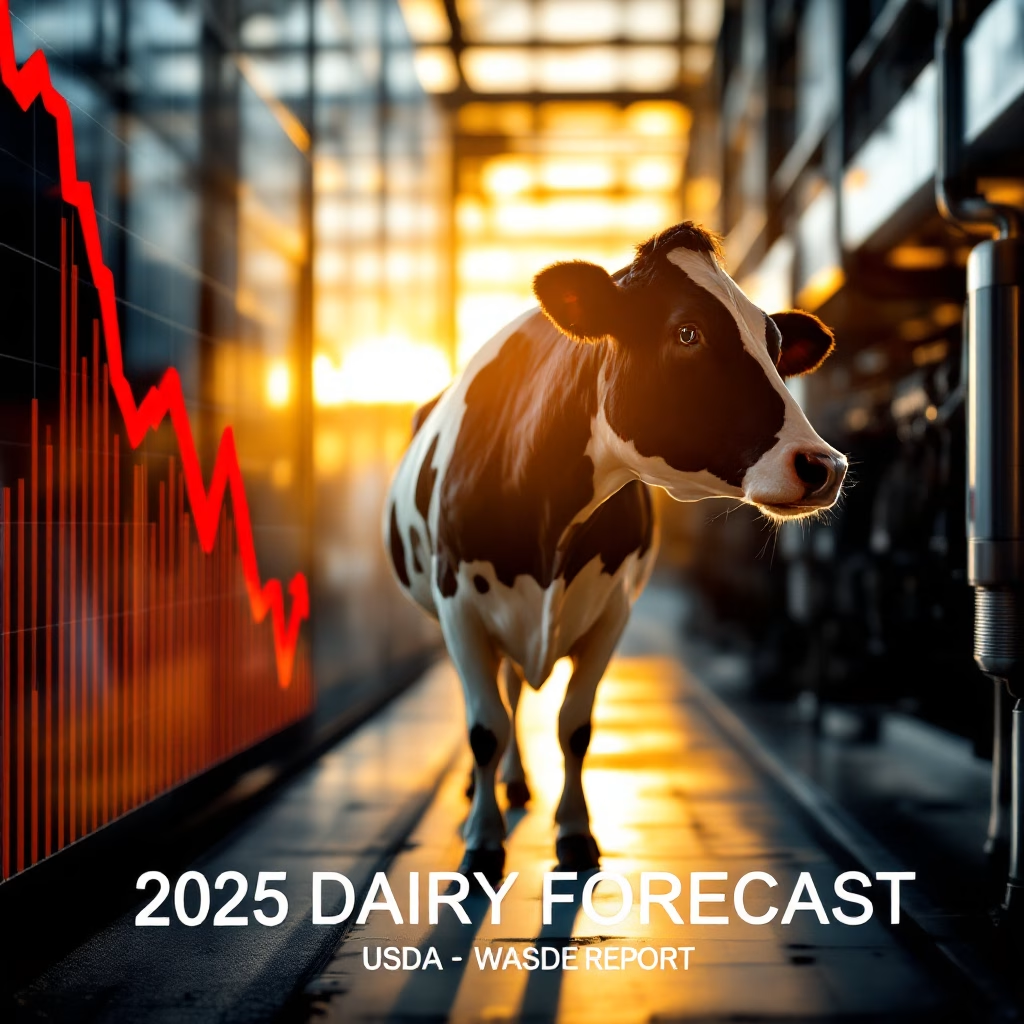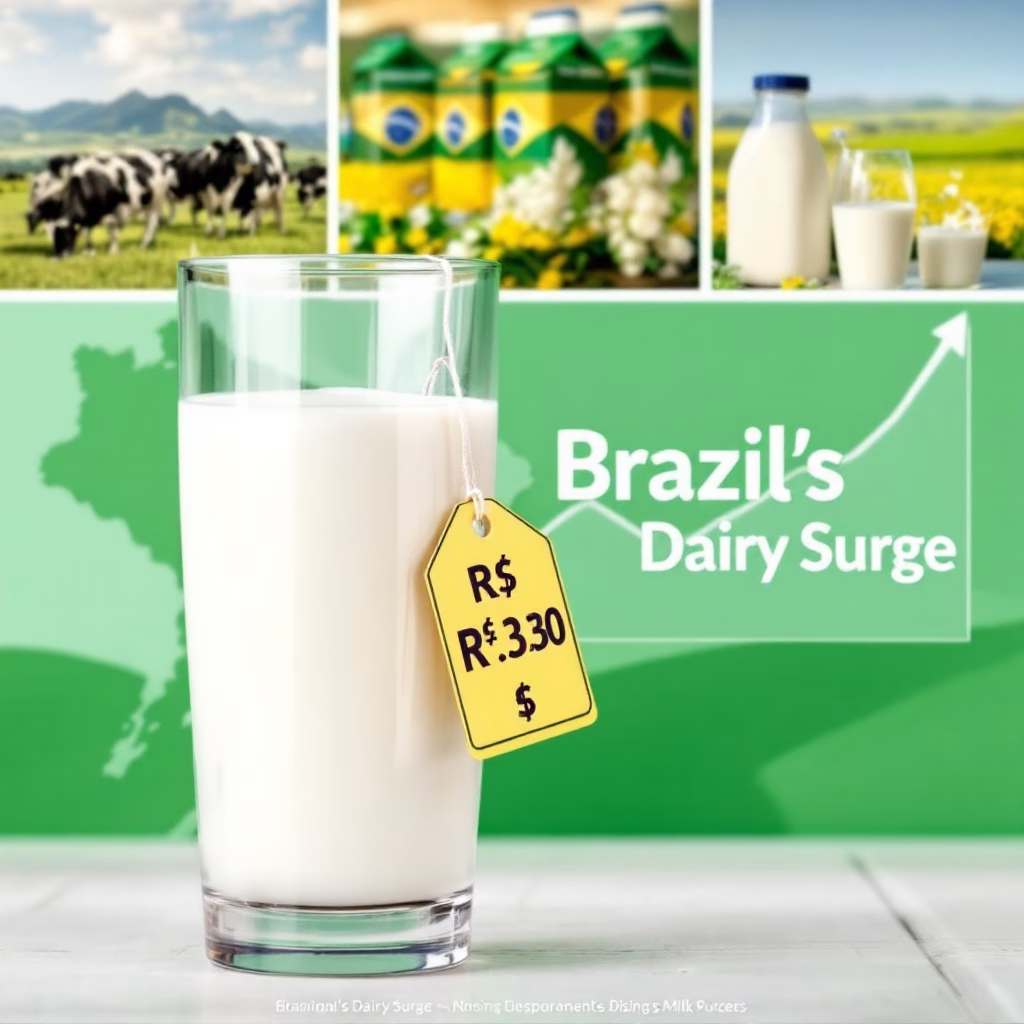U.S. dairy drowning in cream: Can exports save the day? Discover why selling abroad isn’t a quick fix and what smart farmers should do now.
EXECUTIVE SUMMARY: The U.S. dairy industry faces a massive cream surplus, driven by record-high butterfat content, rebounding milk production, and weak food service demand. While exports have surged due to a significant price advantage (U.S. butter at $2.30/lb vs. Europe’s $8,600/MT), structural hurdles prevent a quick fix. These include mismatched butter standards (80% U.S. vs. 82% global), high market entry costs, and volatile tariffs (e.g., Canada’s 25% retaliation). Exports alone won’t drain the glut short-term, but long-term strategies like targeting Latin America, adapting products, and building export infrastructure offer hope. Success requires a shift from opportunistic selling to sustained international market development, potentially transforming U.S. dairy’s global role.
KEY TAKEAWAYS:
- Cream glut stems from multiple factors: 4.43% butterfat content, 1.7% milk production surge, cheese production shifts, and weak food service demand.
- Export growth is impressive (butter +126%, AMF +525% in early 2025) but faces hurdles like 80% vs. 82% butter standards and complex tariffs (e.g., China’s 125% on U.S. dairy).
- Short-term export relief is unlikely due to the scale of surplus (270M lbs butter stocks) and structural barriers.
- Long-term success requires strategic shifts: sustained market development, product adaptation (e.g., 82% unsalted butter), and targeting regions like Mexico/Central America.
- Industry collaboration is crucial: processors must invest in export capabilities, while organizations like USDEC need to address trade barriers and provide market intelligence.

The dairy industry’s swimming in cream right now, with butter prices hitting rock-bottom while international markets are paying nearly double. Everyone’s asking the same question at the co-op meetings: can we export our way out of this mess? The short answer isn’t simple – while our exports are taking off, real-world hurdles mean exports alone won’t bail us out overnight. But with some smart moves, we could turn international sales from an occasional relief valve into a consistent market for our butterfat.
The Perfect Storm: How America’s Cream Glut Formed
Let’s break down how we got here:
Milk Floodgates Open: Big Herds, Bigger Output
Our cows are pumping out richer milk than ever before. Butterfat hit a whopping 4.43% earlier this year – numbers we’ve never seen before. Years of selecting components and feeding for fat have paid off too well.
“We’re making butter Americans don’t want to buy,” says Wisconsin churn operator Mark Tolbert. “Our cows keep pumping out more butterfat while processors scramble to find homes for it all.”
Milk production hasn’t dropped a bit despite losing 39% of our dairy farms between 2017 and 2022. The big operations with 1,000+ cows now make up two-thirds of all milk sales, up from 57% just five years ago.
Production jumped 1.7% late last year, dumping another 160 million pounds of milk fat onto an already flooded market. That’s a lot of butter churns running over.
Cheese Shift Dumps More Cream on Markets
The cheese side isn’t helping either. While cheese production hit a record 14.25 billion pounds last year, the high-fat varieties like Cheddar dropped by 5.8%. That trend’s continuing this year, with American-type cheese production down another 1.3% in February.
Meanwhile, those fancy new cheese plants in Wisconsin and Texas are diverting 15% of our milkfat away from butter – 50% more than last year. More cheese overall, but less fat being used up.
Food Service Weakness Compounds the Problem
Restaurants and bakeries aren’t buying like they used to. The food service sector’s been soft, hitting cream prices hard.
Cream values have tanked to decade lows—farmers now earn just $1.10 for every dollar of butterfat. That’s about as bad as the COVID crash in 2020. Butter churns are running at 92% capacity, just trying to handle all the excess cream.
Export Explosion: U.S. Butterfat’s Global Price Advantage
Here’s where things get interesting – our cheap butter looks mighty attractive overseas.
Fire Sale Prices: U.S. Butter’s Dramatic Discount
Our butter’s selling for $2.30/lb while European butter’s fetching nearly $8,600/MT – a 30% discount even after adjusting for fat differences. We’re practically giving it away compared to world prices.
| Region | Jan 2025 Avg | Feb 2025 Avg | Mar 2025 Avg | Early Apr 2025 Spot/Range |
| U.S. CME Grade AA | ~$5,470/MT | ~$5,246/MT | ~$5,129/MT | ~$5,110-$5,180/MT |
| Europe (W. Europe 82% FOB) | ~$7,400/MT | ~$7,700/MT | ~$8,687/MT | $7,975-$8,600/MT |
| Oceania (82% FOB / GDT) | ~$6,800/MT | ~$7,280/MT | ~$7,550/MT | $7,400-$7,600/MT |
Record-Breaking Export Growth
Buyers overseas aren’t stupid – they’re loading up on our cheap butterfat. Butter exports jumped 41% in January and then exploded by 126% in February, hitting 11.5 million pounds. For the first two months of this year, we’ve shipped 84% more butter than the same time last year.
Anhydrous milkfat (AMF) exports have gone wild – up 525% in January alone. Canada’s buying 239% more, and Mexico’s purchases jumped nearly 1,600%.
| Product | Jan 2025 (MT) | Jan 2024 (MT) | % Change | Feb 2025 (MT) | Feb 2024 (MT) | % Change | Key Destinations |
| Butter | 3,188 | 2,261 | +41% | 5,216 | 2,308 | +126% | Canada, C. America, MENA |
| AMF | 3,897 | 623 | +525% | N/A | N/A | N/A | Canada, Mexico, MENA |
| Total Butterfat | 7,085 | 2,884 | +146% | N/A | N/A | N/A | – |
For the first time in over two years, we exported more butter than we imported in February. That’s a big shift.
Why Selling Overseas Isn’t a Quick Fix
So why can’t exports solve everything? There are some real roadblocks:
The 80% vs. 82% Butter Battle
Our standard butter is 80% fat and usually salted. The rest of the world wants 82% unsalted. That’s not just a small detail – it means retooling production lines and changing processes. You can’t just take butter meant for Kroger and ship it to Saudi Arabia.
AMF: America’s Secret Export Weapon
AMF (that’s almost pure butterfat at 99%) doesn’t have the same standards problem as butter, which explains why it’s selling like hotcakes overseas. For processors looking to move butterfat fast, AMF is the easier path than reformulating butter production.
The Tariff Minefield
The trade situation is a mess right now. The White House slapped 25% tariffs on Canada and Mexico in March, and they hit back hard. Canada put 25% tariffs on our dairy, and China went nuclear with 125% tariffs on U.S. dairy products.
| Trading Partner | U.S. Tariff Action | Partner Retaliation on Dairy | Impact on Exports |
| Canada | 25% on non-USMCA goods | 25% on U.S. dairy products | Potentially negates price advantage |
| Mexico | 25% on non-USMCA goods | Retaliation announced, but details pending | Creates uncertainty for the largest export market |
| China | 20% IEEPA tariff + existing tariffs | 125% on U.S. dairy products | Challenges the third-largest dairy market |
The National Milk Producers’ Federation admits these tariffs will “certainly be a hit to our exports to China.” Even with USMCA exemptions, the uncertainty has everyone on edge.
Market Entry Costs and Historical Inertia
Breaking into export markets isn’t like selling to the following country. Companies need international sales teams, specialized paperwork experts, and relationships with buyers overseas. All that takes time and money.
The U.S. has traditionally imported butter rather than exported it, so we don’t have the connections and systems we do for powder or cheese. You can’t flip that switch overnight.
Exporting the Surplus: Short-Term Pain, Long-Term Gain
Why Exports Won’t Immediately Eliminate the Cream Glut
Let’s be realistic – exports alone can’t fix this overnight:
- The sheer scale of the problem is massive. Butter stocks jumped 26% in January alone to over 270 million pounds.
- The hurdles we discussed – different butter standards, export costs, and crazy tariff situations – all slow down the export machine.
- Building international relationships takes time. You can’t just call up a buyer in Saudi Arabia and ship tomorrow.
So while exports will help, we’ll likely need other fixes too – maybe producing less milk fat or finding new uses here at home.
Strategic Path Forward: Building Long-Term Export Capacity
But there’s good news for the long haul. If we play this right, exports could become a reliable outlet for our butterfat:
- Sustained Export Investment: Processors must stop treating exports as a dumping ground for surplus and start building a real, long-term international business.
- Strategic Market Targeting: Mexico and Central America make natural targets – they’re close by and have favorable trade deals like CAFTA-DR with zero dairy tariffs.
- Product Adaptation: Plants should consider dedicated lines for 82% unsalted butter or focus more on AMF production since it’s already selling well overseas.
- Enhanced Industry Collaboration: The U.S. Dairy Export Council needs everyone’s support to open doors and fight trade barriers.
Cream Rising: The Future of U.S. Butterfat Exports
This cream glut is both a crisis and an opportunity. While exports won’t immediately drain the lake, they’re becoming crucial to the solution. The export boom we’re seeing proves that when the price is right, buyers will come.
Going forward, we need a multi-pronged approach. On the export side, we must build lasting relationships, adapt our products, and navigate the trade minefield. We might need to rethink milk composition, production volumes, or processing capacity at home.
Can we export our way out of the cream glut? Not overnight. But with smart investments and a long-term view, exports can become a consistent market for our butterfat rather than just an emergency outlet when prices crash.
3 Steps to Survive the Cream Glut
- Audit your herd’s butterfat trends with your nutritionist. Are you still selecting and feeding for maximum components when the market’s drowning in fat?
- Demand export-ready pricing from your co-op. If they’re selling cream at rock-bottom prices domestically, ask what they’re doing to capture higher international values.
- Attend USDEC’s June webinar on navigating tariff complexities. Understanding the rapidly changing trade landscape is essential for long-term planning.
Exports might seem distant for those of us with our boots in the barn every day, but they’re becoming crucial to our bottom line. Those who see the global market as a real opportunity – not just a place to dump surplus – will still be milking cows when this shakes out. The U.S. can become a consistent global supplier of high-quality butterfat, but it’ll take patience, investment, and a long-term vision.
Learn more:
- Trade War Drama Sends Cheese Prices Plunging to 11-Month Lows
Explore how global trade tensions and overproduction are impacting cheese prices, butter values, and milk futures, with actionable strategies for producers. - U.S. Dairy Surplus Deepens: Butter Glut Hits 3-Year High as Cheese Inventories Defy Expectations
Dive into the data behind record-high butter stocks, collapsing cream multiples, and shifting consumer preferences toward imported butter. - Dairy Caught in Trump’s Tariff Crosshairs as Rollins Teases Trade Deals by Friday
Understand the impact of Trump’s sweeping tariffs on dairy exports and learn survival strategies for navigating unprecedented price volatility.
 Join the Revolution!
Join the Revolution!
Join over 30,000 successful dairy professionals who rely on Bullvine Daily for their competitive edge. Delivered directly to your inbox each week, our exclusive industry insights help you make smarter decisions while saving precious hours every week. Never miss critical updates on milk production trends, breakthrough technologies, and profit-boosting strategies that top producers are already implementing. Subscribe now to transform your dairy operation’s efficiency and profitability—your future success is just one click away.







 Join the Revolution!
Join the Revolution!








































































